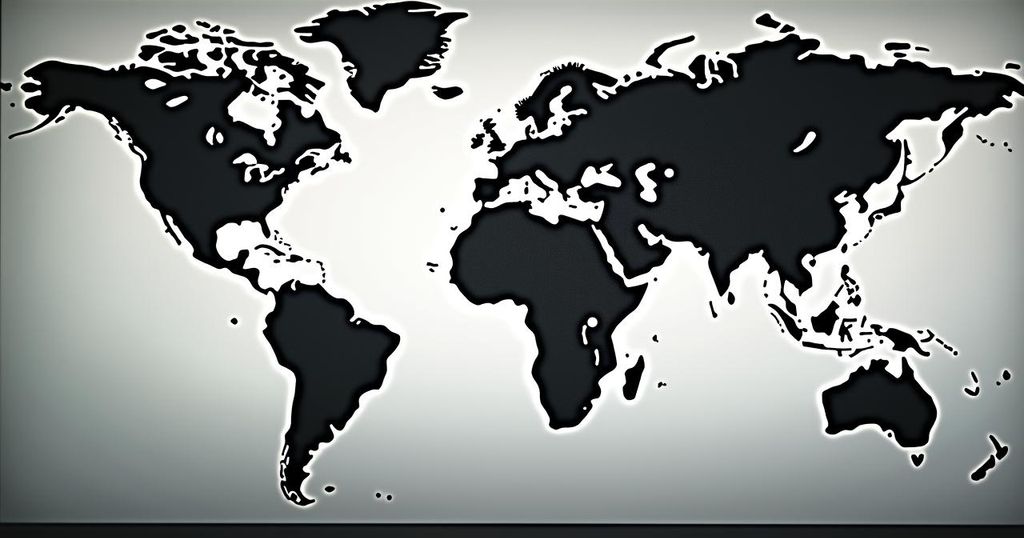During his speech at the UN General Assembly, Israeli Prime Minister Benjamin Netanyahu presented two maps, depicting parts of the Middle East, with both maps omitting any mention of Palestine. He linked Iranian influence to regional conflicts, emphasizing Israel’s military responses to threats from Iranian-backed groups while highlighting relationships with nations such as Saudi Arabia, Egypt, Sudan, and India as part of a burgeoning alliance. Netanyahu’s presentation prompted a walkout from numerous diplomats, reflecting the contentious nature of the discourse.
Israeli Prime Minister Benjamin Netanyahu delivered a provocative address at the United Nations General Assembly, where he presented two distinct maps to emphasize the political landscape of the Middle East. In his right hand, he held a map labeled “The Curse,” depicting Iran, Iraq, Syria, and Yemen in black. In contrast, his left hand featured a map termed “The Blessing,” showcasing countries such as Egypt, Sudan, Saudi Arabia, and India in green. Notably absent from both maps was any representation of Palestine, which indicated its erasure from the regional discourse according to Netanyahu’s narrative. Netanyahu linked the black map to Iranian influence, condemning Iran and its allies as the root cause of persistent regional conflicts. He called attention to Tehran’s military and financial support for groups such as Hezbollah in Lebanon and Hamas in Gaza, asserting that Israel was compelled to act defensively against Iranian-backed factions. In addressing the UN, Netanyahu asserted a unilateral message to Iran, saying, “If you strike us, we will strike you,” emphasizing Israel’s readiness to extend its military reach if necessary. His presentation prompted a significant response, with numerous diplomats walking out in protest. He further articulated that Israel’s ongoing military operations in Lebanon and Gaza were justified responses to sustained Iranian aggression. He maintained that while Hezbollah remained belligerent, Israel would have no alternative but to neutralize what he identified as a direct threat. Among the countries marked in green, particular attention was given to Saudi Arabia, which was involved in discussions regarding normalization of relations with Israel prior to the recent conflict with Hamas. Netanyahu’s inclusion of Saudi Arabia in the “blessing” area seemed to signal optimism regarding future diplomatic developments despite the complexities surrounding Palestinian statehood, a requirement publicly stated by Saudi officials. Egypt’s positioning on the map reflected a complicated but established peace since the 1979 treaty, characterized by security cooperation and gas imports from Israel, even if Egypt’s public stance on Israeli military actions in Gaza remains critical. Sudan’s normalization with Israel following the Abraham Accords marked a dramatic shift in its diplomatic posture, while India’s representation highlighted the strengthening ties of cooperation under Prime Minister Narendra Modi, particularly in defense and technology sectors, despite India’s historical support for Palestinian rights.
The geopolitical dynamics of the Middle East are often characterized by complex alliances and longstanding conflicts. The Arab-Israeli conflict remains a central issue, with the status of Palestine at its core. Recent efforts for normalization between Israel and several Arab states have been influenced heavily by broader regional strategies against Iranian influence. Prime Minister Netanyahu’s presentation at the UN reflects a narrative aimed at solidifying Israel’s alliances and portraying its military actions as necessary for self-defense against perceived external threats, particularly from Iran and its affiliates.
In summary, Prime Minister Netanyahu’s address to the UN underscored the ongoing tensions and geopolitical complexities of the Middle East, marked by his illustrative maps that exclude Palestine. By denouncing Iran as the main antagonist in regional instability, he sought to reinforce Israel’s position amidst changing dynamics with neighboring countries. The failed normalization agreements due to the Palestinian issue illustrate the enduring challenges that lie ahead. This presentation, met with diplomatic protest, encapsulated the contentious atmosphere surrounding Israel’s foreign policy and military strategies.
Original Source: www.ndtv.com






